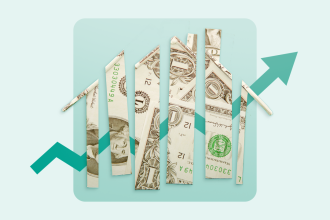Key takeaways
- Balance transfers can be an effective tool for paying off high-interest debt, but they aren’t a magic bullet.
- If you aren’t able to pay your transferred balance in full before the end of your 0 percent APR window, carrying out another transfer can help you to further stave off interest payments.
- However, while balance transfers can help with debt payoff, it’s important to be aware of their potential risks and alternatives.
- Making a habit of frequent balance transfers may indicate larger financial issues that need to be addressed.
When it comes to paying down debt without the heavy burden of high interest rates, balance transfers can be among your most effective tools. But what happens if you reach the end of your introductory annual percentage rate (APR) window and haven’t fully paid your balance?
If you’re unable to pay off your transferred balance before the low- to no-interest window closes, you’ll find yourself once again paying a high interest rate on what you owe. In this case, another balance transfer could help you buy more time, as the best balance transfer cards offer up to 21 months interest-free.
There’s no shame in taking advantage of the financial tools available to you. Still, balance transfers carry both rewards and risks. Before you opt for one — or more than one — understand the basics of balance transfers, including what to look out for and alternatives.
Can you make multiple balance transfers to avoid interest?
Yes, you can transfer multiple balances to a new balance transfer card. You can also transfer balances from one 0 percent APR credit card to another or open up new credit cards to carry out multiple balance transfers. Depending on the issuer or card, you might also be able to move debts outside of credit cards through a balance transfer check or through an electronic transfer from another eligible account.
Transferring multiple balances to one balance transfer card
If you’re planning on transferring multiple balances to just one balance transfer card, you’ll have to be ready to pay a balance transfer fee with each transfer. Some cards, like some from credit unions, don’t have balance transfer fees, but most of the popular balance transfer cards you’ll encounter do have these fees.
Jim Triggs, president and CEO of the nonprofit consumer credit counseling agency Money Management International, calls out these fees as especially important for consumers.
“It is important to consider these fees when looking to transfer one card balance to another, and not only consider the introductory interest rate,” says Triggs.
The number of balance transfers you’re able to complete is also likely to be restricted by the credit limit on your new balance transfer card. You’ll have to take into account the balance you want to transfer plus the balance transfer fee associated with it and make sure it adds up to less than your credit limit. Plus, in some cases, balance transfer credit limits are lower than the main credit limit for traditional card transactions, so you won’t be able to max out your card’s entire credit limit to begin with.
Transferring multiple balances to multiple balance transfer cards
If you apply for several new balance transfer cards around the same time with the plan of spreading your balances across multiple cards, your borrowing power could be curbed by your creditworthiness. This is because your credit is likely to take a small hit with each new card inquiry. You may also be held back by a card issuer’s own rules on the number of balance transfers it allows.
Keep in mind: Instead of opening up multiple new cards, you may be able to get balance transfer offers on existing cards. Issuers are known to reach out to existing cardholders with balance transfer offers occasionally, though your rate may not be as low — or your intro period as long — as with a new balance transfer credit card.
Transferring a balance from one balance transfer card to another after your intro APR offer ends
If your introductory APR offer is nearing its end, you can try to open a new balance transfer card and move your balance over — but you’ll have to pay another balance transfer fee to do this. Also, if your credit score has dropped at all in the meantime, you might not qualify for the best balance transfer cards out there.
Still, this could be a good option for those who just need a little more time to pay down their balance or those who feel confident that they can stick to a payment plan for their new card.
Can you keep transferring the same credit card balance to a new card?
Technically, yes, you can move a balance to a new card and then repeat the process over and over again — but that’s not feasible in the long run. As mentioned previously, you’ll have to pay a balance transfer fee each time you make a transfer. This method also won’t address the root cause of having to carry debt like this. You can also start to run out of options when it comes to credit products to continue your transfers. Most credit card issuers won’t let you transfer debt between cards of the same issuer.
What are the risks of multiple balance transfers?
Under many circumstances, multiple balance transfers can support a larger debt-payoff strategy, though stay aware of potential risks that include:
- Fees for each transfer. Fees for balance transfers are typically 3 percent or 5 percent of each transfer amount, with a typical minimum of $5 to $10. These fees can eat into your savings, if you’re not careful.
- Failure to maximize intro period. To get the most out of your balance transfers, it’s ideal to pay off all transferred debts in full before the intro period expires. You may enjoy a 0 percent intro APR for 15 months, for instance — but after 15 months, the APR on the transferred balance reverts to a higher interest rate — one that’s likely in the double digits.
- Multiple inquiries and payments. If you’re applying for more than one balance transfer card at the same time, every hard inquiry from a card issuer shows up on your credit report, multiplying the temporary, minimal impact on your credit score. You’ll also need to keep track of yet more monthly bills across your new cards.
- Not addressing underlying issues. A balance transfer can ease your financial burden, but it may not help you tackle serious issues with your finances, such as overspending beyond what you can comfortably afford to pay back.
Balance transfers from one credit card to another can be a good way to save money in interest charges while paying off a credit card balance. However, if a consumer is using balance transfers to consistently move balances from one card to another in order to avoid making payments on the card or at least put off payment for a while, they will eventually run into issues.
— Jim Triggs, president and CEO of Money Management International
Balance transfer alternatives
While a balance transfer can be a useful tool for whittling down high-interest debts, it isn’t the only option. Consider these four alternatives to balance transfers before applying for your new card:
- A strong budget. Getting a handle on high-interest debt may boil down to one simple step — creating a monthly budget. A monthly budget allows you to track your income against such regular expenses as rent, card payments, loan payments and utilities. Pencil and paper is a good start, though many of the best budgeting apps offer enhanced features that can encourage you to get on — and stay on — track.
- Debt consolidation. You may be able to combine high-interest debts into a single debt consolidation loan (and a single monthly payment). If you go down this path, aim for an interest rate on the loan that’ll wind up saving you money on interest charges.
- Debt counseling. A nonprofit consumer credit counseling agency can be a strong shoulder when assessing your finances, setting up a budget and coming up with solutions to ease your debt burden. One such solution may be a debt management plan designed to pay off unsecured debts — such as credit cards — at negotiated interest rates.
- Debt relief. A for-profit debt relief company promises to negotiate with your creditors to decrease the amount of debt you owe — typically unsecured debts like credit cards. The Consumer Finance Protection Bureau cautions debt relief programs as a last resort due to the possibility of finding yourself in a worse financial situation after sign-up.
How to break the cycle if you’re on a second balance transfer
Although multiple balance transfers might sound like a good approach to chipping away at high-interest debt, too many risks can mask a deeper problem with your finances.
You cannot borrow your way out of debt. Moving balances for better interest rates may be helpful temporarily, but it will not solve your debt challenges if you are dealing with too much overall debt.
— Jim Triggs, president and CEO of Money Management International
So, how do you break the credit card debt cycle?
Triggs recommends putting together — and sticking to — a plan to pay off your high-interest debts that can include a balance transfer without depending on it.
“A consumer is never guaranteed the ability to open a new line of credit to transfer balances to. If the economy gets worse and credit tightens further, new lines of credit, especially for struggling consumers, may be harder to come by,” he says.
Jeanne Kelly, a credit coach, echoes this sentiment, and Kelly stresses the importance of prioritizing debt reduction in order to escape the cycle of balance transfers. If you’re not aggressive about paying down a transferred balance, “the debt will just continue to grow,” she says.
The bottom line
A balance transfer lets you pay off debt without worrying about double-digit interest rates — as long as you can prioritize paying off amounts you transfer within the specified intro period. If you can, a balance transfer just might put you on the path to financial health.
But if you make a habit of frequent balance transfers, you might not as readily recognize the more serious issues with your finances — like spending beyond your budget or racking up debts you can’t comfortably pay off.
Read the full article here














